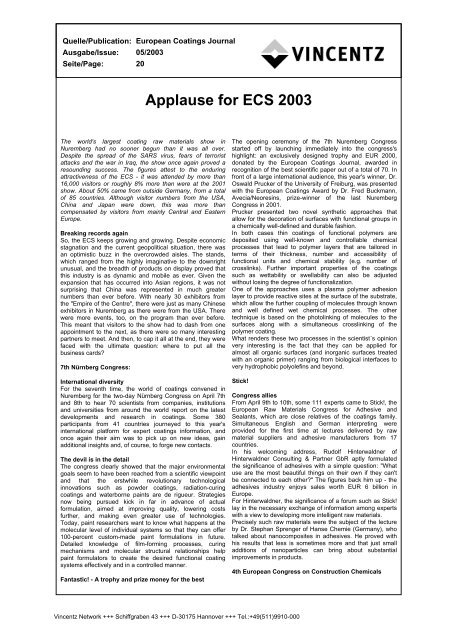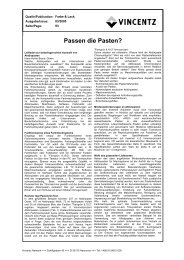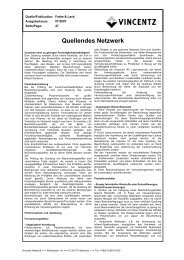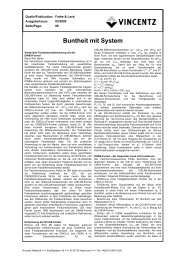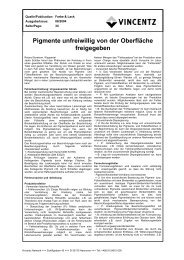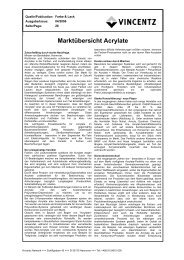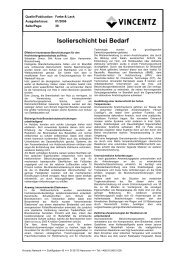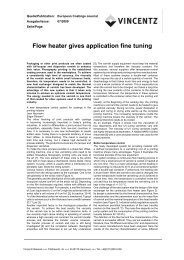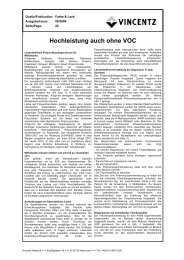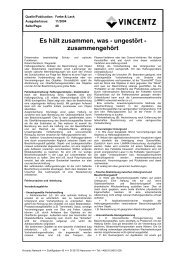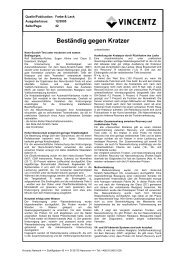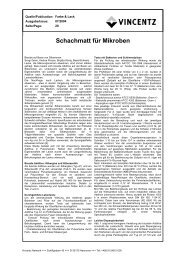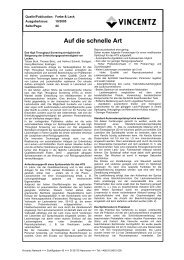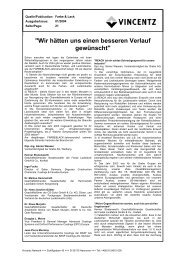Applause for ECS 2003 - European-coatings.com
Applause for ECS 2003 - European-coatings.com
Applause for ECS 2003 - European-coatings.com
You also want an ePaper? Increase the reach of your titles
YUMPU automatically turns print PDFs into web optimized ePapers that Google loves.
Quelle/Publication: <strong>European</strong> Coatings Journal<br />
Ausgabe/Issue: 05/<strong>2003</strong><br />
Seite/Page: 20<br />
The world's largest coating raw materials show in<br />
Nuremberg had no sooner begun than it was all over.<br />
Despite the spread of the SARS virus, fears of terrorist<br />
attacks and the war in Iraq, the show once again proved a<br />
resounding success. The figures attest to the enduring<br />
attractiveness of the <strong>ECS</strong> - it was attended by more than<br />
16,000 visitors or roughly 8% more than were at the 2001<br />
show. About 50% came from outside Germany, from a total<br />
of 85 countries. Although visitor numbers from the USA,<br />
China and Japan were down, this was more than<br />
<strong>com</strong>pensated by visitors from mainly Central and Eastern<br />
Europe.<br />
Breaking records again<br />
So, the <strong>ECS</strong> keeps growing and growing. Despite economic<br />
stagnation and the current geopolitical situation, there was<br />
an optimistic buzz in the overcrowded aisles. The stands,<br />
which ranged from the highly imaginative to the downright<br />
unusual, and the breadth of products on display proved that<br />
this industry is as dynamic and mobile as ever. Given the<br />
expansion that has occurred into Asian regions, it was not<br />
surprising that China was represented in much greater<br />
numbers than ever be<strong>for</strong>e. With nearly 30 exhibitors from<br />
the "Empire of the Centre", there were just as many Chinese<br />
exhibitors in Nuremberg as there were from the USA. There<br />
were more events, too, on the program than ever be<strong>for</strong>e.<br />
This meant that visitors to the show had to dash from one<br />
appointment to the next, as there were so many interesting<br />
partners to meet. And then, to cap it all at the end, they were<br />
faced with the ultimate question: where to put all the<br />
business cards?<br />
7th Nürnberg Congress:<br />
International diversity<br />
For the seventh time, the world of <strong>coatings</strong> convened in<br />
Nuremberg <strong>for</strong> the two-day Nürnberg Congress on April 7th<br />
and 8th to hear 70 scientists from <strong>com</strong>panies, institutions<br />
and universities from around the world report on the latest<br />
developments and research in <strong>coatings</strong>. Some 380<br />
participants from 41 countries journeyed to this year's<br />
international plat<strong>for</strong>m <strong>for</strong> expert <strong>coatings</strong> in<strong>for</strong>mation, and<br />
once again their aim was to pick up on new ideas, gain<br />
additional insights and, of course, to <strong>for</strong>ge new contacts.<br />
The devil is in the detail<br />
The congress clearly showed that the major environmental<br />
goals seem to have been reached from a scientific viewpoint<br />
and that the erstwhile revolutionary technological<br />
innovations such as powder <strong>coatings</strong>, radiation-curing<br />
<strong>coatings</strong> and waterborne paints are de rigueur. Strategies<br />
now being pursued kick in far in advance of actual<br />
<strong>for</strong>mulation, aimed at improving quality, lowering costs<br />
further, and making even greater use of technologies.<br />
Today, paint researchers want to know what happens at the<br />
molecular level of individual systems so that they can offer<br />
100-percent custom-made paint <strong>for</strong>mulations in future.<br />
Detailed knowledge of film-<strong>for</strong>ming processes, curing<br />
mechanisms and molecular structural relationships help<br />
paint <strong>for</strong>mulators to create the desired functional coating<br />
systems effectively and in a controlled manner.<br />
Fantastic! - A trophy and prize money <strong>for</strong> the best<br />
<strong>Applause</strong> <strong>for</strong> <strong>ECS</strong> <strong>2003</strong><br />
The opening ceremony of the 7th Nuremberg Congress<br />
started off by launching immediately into the congress's<br />
highlight: an exclusively designed trophy and EUR 2000,<br />
donated by the <strong>European</strong> Coatings Journal, awarded in<br />
recognition of the best scientific paper out of a total of 70. In<br />
front of a large international audience, this year's winner, Dr.<br />
Oswald Prucker of the University of Freiburg, was presented<br />
with the <strong>European</strong> Coatings Award by Dr. Fred Buckmann,<br />
Avecia/Neoresins, prize-winner of the last Nuremberg<br />
Congress in 2001.<br />
Prucker presented two novel synthetic approaches that<br />
allow <strong>for</strong> the decoration of surfaces with functional groups in<br />
a chemically well-defined and durable fashion.<br />
In both cases thin <strong>coatings</strong> of functional polymers are<br />
deposited using well-known and controllable chemical<br />
processes that lead to polymer layers that are tailored in<br />
terms of their thickness, number and accessibility of<br />
functional units and chemical stability (e.g. number of<br />
crosslinks). Further important properties of the <strong>coatings</strong><br />
such as wettability or swellability can also be adjusted<br />
without losing the degree of functionalization.<br />
One of the approaches uses a plasma polymer adhesion<br />
layer to provide reactive sites at the surface of the substrate,<br />
which allow the further coupling of molecules through known<br />
and well defined wet chemical processes. The other<br />
technique is based on the photolinking of molecules to the<br />
surfaces along with a simultaneous crosslinking of the<br />
polymer coating.<br />
What renders these two processes in the scientist´s opinion<br />
very interesting is the fact that they can be applied <strong>for</strong><br />
almost all organic surfaces (and inorganic surfaces treated<br />
with an organic primer) ranging from biological interfaces to<br />
very hydrophobic polyolefins and beyond.<br />
Stick!<br />
Vincentz Network +++ Schiffgraben 43 +++ D-30175 Hannover +++ Tel.:+49(511)9910-000<br />
Congress allies<br />
From April 9th to 10th, some 111 experts came to Stick!, the<br />
<strong>European</strong> Raw Materials Congress <strong>for</strong> Adhesive and<br />
Sealants, which are close relatives of the <strong>coatings</strong> family.<br />
Simultaneous English and German interpreting were<br />
provided <strong>for</strong> the first time at lectures delivered by raw<br />
material suppliers and adhesive manufacturers from 17<br />
countries.<br />
In his wel<strong>com</strong>ing address, Rudolf Hinterwaldner of<br />
Hinterwaldner Consulting & Partner GbR aptly <strong>for</strong>mulated<br />
the significance of adhesives with a simple question: "What<br />
use are the most beautiful things on their own if they can't<br />
be connected to each other?" The figures back him up - the<br />
adhesives industry enjoys sales worth EUR 6 billion in<br />
Europe.<br />
For Hinterwaldner, the significance of a <strong>for</strong>um such as Stick!<br />
lay in the necessary exchange of in<strong>for</strong>mation among experts<br />
with a view to developing more intelligent raw materials.<br />
Precisely such raw materials were the subject of the lecture<br />
by Dr. Stephan Sprenger of Hanse Chemie (Germany), who<br />
talked about nano<strong>com</strong>posites in adhesives. He proved with<br />
his results that less is sometimes more and that just small<br />
additions of nanoparticles can bring about substantial<br />
improvements in products.<br />
4th <strong>European</strong> Congress on Construction Chemicals
Quelle/Publication: <strong>European</strong> Coatings Journal<br />
Ausgabe/Issue: 05/<strong>2003</strong><br />
Seite/Page: 20<br />
Premiere with simultaneous translation<br />
During the one-day 4th Construction Chemicals Congress<br />
on April 10th, 12 select lectures dealt with current scientific<br />
and technical developments as well as topics of interest<br />
from within the sector. Simultaneous interpreting was<br />
provided <strong>for</strong> the first time and attracted a large contingent of<br />
delegates from <strong>for</strong>eign countries.<br />
Rainer Sobek, vice-president of German Bauchemie e.V.,<br />
opened the congress in confident tones, drawing attention to<br />
the high importance of the construction chemicals, including<br />
its social dimension: "Important buildings throughout the<br />
world cannot be - and could not have been - built without the<br />
use of construction chemical products". But he also<br />
addressed the problems besetting the construction<br />
chemicals sector, especially in Germany: "The weakness in<br />
the German construction sector is now in its 5th year - we<br />
do not feel like celebrating". But it is precisely in difficult<br />
times that there is a great need to exchange in<strong>for</strong>mation and<br />
knowledge - this too was revealed by the 4th Construction<br />
Chemicals Congress.<br />
2nd Ink Makers' Forum<br />
All about inks<br />
The printing inks market is currently going through hard<br />
times, but this is actually <strong>for</strong>cing a certain amount of<br />
differentiation on the ink manufacturers - the thing to do now<br />
is to stand out from the market not only in cost but also in<br />
technological leadership. During the <strong>ECS</strong>, the Ink Makers'<br />
Forum, 2nd <strong>European</strong> Congress on Printing Inks, provided<br />
an opportunity to hear about technical details from<br />
international experts on current innovations in the fields of<br />
binders, pigments and colorants, additives <strong>for</strong> printing ink<br />
<strong>for</strong>mulations as well as on new production and testing<br />
technology.<br />
The 70 delegates from 14 countries heard 23 expert lectures<br />
- spread <strong>for</strong> the first time over two days - that reflected the<br />
full range of current developments in printing inks, and also<br />
discussed the current market and legislative situation.<br />
In the opening session, Martin Kanert (VDMi/CEPE),<br />
especially, caused a stir when he explained the impact that<br />
the planned EU chemicals policy - to the extent it is known -<br />
would have on the printing inks industry, and he then<br />
<strong>for</strong>mulated CEPE's position on this. An important point of his<br />
deliberations: according to estimates, the costs of chemical<br />
registration as provided <strong>for</strong> under the REACH program<br />
would increase the cost of substances produced in<br />
quantities of less than 1 t/a by around 42% (this figure being<br />
<strong>com</strong>mensurately lower <strong>for</strong> larger amounts): 10 t/a: 11%, 100<br />
t/a: 5%, 1000 t/a: 2%, 10,000 t/a: 0.4%). Of course,<br />
additives will be mostly affected by this. The probable<br />
consequence would be the disappearance of a large<br />
number of chemicals from the market. The German VCI<br />
estimates that this will be the case <strong>for</strong> 20 to 40% of<br />
substances produced in quantities ranging from 1 to 100 t/a.<br />
Some highlights from the technical sessions<br />
The migration of unreacted photoinitiators and their<br />
breakdown products from UV cured inks is of increasing<br />
concern in the food packaging industry. R. Stephen<br />
Davidson presented on behalf of Coates Lorilleux new<br />
multifunctional photoinitiators (MFPI's) that have been<br />
developed to reduce the amounts of extractable<br />
<strong>com</strong>ponents in UV-cured coating. Because of their<br />
multifunctionality, the photoinitiators are firmly embedded<br />
within the binder during cure, while still keeping a good<br />
reactivity to achieve full cure of the system.<br />
The "dynamic fingerprint" of any ink <strong>for</strong>mulation can be<br />
generated with a time-dependent differential maximum<br />
bubble pressure technique. As Victor P. Janule (ChemDyne)<br />
explained, this allows <strong>for</strong>mulators to characterize the ink<br />
per<strong>for</strong>mance under all possible process conditions be<strong>for</strong>e<br />
the ink is used. This is especially important when multiple<br />
surfactants are present in the <strong>for</strong>mulation. As the<br />
measurements show, the <strong>for</strong>mulations that give the lowest<br />
surface tension may not be the best.<br />
Wim Peter Stout (Air Products) talked about how important it<br />
is to adjust and control surface tension in printing inks.<br />
Acetylenic diols are well known as high per<strong>for</strong>ming additives<br />
<strong>for</strong> the waterborne liquid inks, showing the technical<br />
advantages offered by Gemini surfactants. Stout presented<br />
a new generation of these additives, which offer even better<br />
per<strong>for</strong>mance benefits.<br />
Jörg Seubert (Eckart Werke) presented new aluminium<br />
metal pigments that can be produced as very thin platelets<br />
of highly uni<strong>for</strong>m thickness by means of PVD (physical<br />
vapour deposition). These pigments exhibit pronounced<br />
non-leafing behaviour and the binder protects them very well<br />
in printing inks against mechanical and chemical influences.<br />
They are ideal <strong>for</strong> mirror-effect inks. They are not meant to<br />
<strong>com</strong>pete against conventional metal effect printing inks, but<br />
rather to replace metallising layers, e.g. in packaging and<br />
labels. The advantage of these mirror-effect inks is that they<br />
can be applied precisely and exclusively to the areas where<br />
they are used in the decoration - this is not possible with<br />
metallisation.<br />
Masterbatch Day: Small but distinguished<br />
Some 28 international masterbatch manufacturers gathered<br />
at the <strong>ECS</strong> in a relaxed atmosphere <strong>for</strong> their first joint <strong>for</strong>um:<br />
Masterbatch Day. A series of five short lectures gave them<br />
an insight into pigments (white, carbon black and effect<br />
pigments), waxes and especially <strong>European</strong> legislation,<br />
which is of vital concern to them as masterbatch<br />
<strong>for</strong>mulators. The various directives, guidelines and<br />
ordinances addressed were those on preparations, material<br />
safety data sheets, hazardous goods, toys, packaging and<br />
waste, and materials and articles intended <strong>for</strong> food contact.<br />
Substantial breaks during the day ensured there was plenty<br />
of time to get to know each other and to trade expertise.<br />
East & West: Connecting Europe<br />
Neighbours mingling<br />
Up until now a "mere" <strong>for</strong>um, the <strong>European</strong> <strong>coatings</strong><br />
convention "East & West: Connecting Europe" was<br />
expanded this year to include a lecture series. The lectures<br />
delivered by the leading paint managers from Western,<br />
Central and Eastern Europe were received with great<br />
interest. An audience of 120 used the chance on April 9th to<br />
find out about the various national markets, to hear statistics<br />
and to catch up on local trends. Where else is there an<br />
opportunity to get firsthand basic data on, <strong>for</strong> example, the<br />
Estonian <strong>coatings</strong> market? As David O'Brock of Viru Keemia<br />
Grupp explained, some 14,400 metric tonnes of paints and<br />
surface <strong>coatings</strong> were produced there in 2001, with 36% of<br />
the market held by non-Estonian <strong>com</strong>panies. The various<br />
speakers demonstrated the potential af<strong>for</strong>ded by the various<br />
East <strong>European</strong> <strong>coatings</strong> markets with the aid of market<br />
analyses and surveys. The atmosphere remained intimate<br />
and in<strong>for</strong>mal throughout; contact between east and west<br />
smoothly transcended whatever linguistic borders there<br />
might have been. This <strong>coatings</strong> event has now developed<br />
into a valuable in<strong>for</strong>mation and contact mart. Simultaneous<br />
interpreting was provided <strong>for</strong> the two Russian lectures. The<br />
remaining contributions were delivered in English.<br />
Workshop Production Technology<br />
Vincentz Network +++ Schiffgraben 43 +++ D-30175 Hannover +++ Tel.:+49(511)9910-000
Quelle/Publication: <strong>European</strong> Coatings Journal<br />
Ausgabe/Issue: 05/<strong>2003</strong><br />
Seite/Page: 20<br />
International dialogue<br />
The second-ever Workshop Production Technology had a<br />
very international flavour this year. 49 participants from 15<br />
countries made the journey to the NürnbergMesse<br />
conference center on April 9th. Non-German countries made<br />
up 65% of the total. Besides many audience members from<br />
Germany's neighbouring countries, some had also <strong>com</strong>e<br />
from as far afield as India and Tanzania. To make the<br />
lecture series attractive to the widest circle of participants,<br />
the organizers had devised a program that more or less<br />
dispensed with specialist topics.<br />
Dr. Olaf Eichstaedt, an excellent and engaging moderator,<br />
guided the participants through the day, which was often<br />
characterized by intense discussions. The first of these<br />
came during general questions on the opening lecture by<br />
John E. Dunstone of Orr & Boss management consultancy<br />
on issues of the design of paints and coating shops. One of<br />
his core premises was indisputable, namely that simplicity is<br />
generally the key to success. The remaining lectures<br />
covered different aspects of production technology in detail<br />
and illustrated the possibilities and limitations of both new<br />
and developed processes. Two successive lectures on<br />
quintessentially different inline technologies, <strong>for</strong> example,<br />
made <strong>for</strong> interesting <strong>com</strong>parison. And then, right at the end,<br />
the excitement level rose reached a new pitch with the<br />
presentation of a method, fresh out of the development<br />
stage, <strong>for</strong> manufacturing printing inks. The method provides<br />
<strong>for</strong> production on extruders, which make continuous<br />
production theoretically possible and there<strong>for</strong>e have an<br />
advantage over conventional equipment, particularly where<br />
mass production is concerned.<br />
Purchasers' Day<br />
A multifaceted premiere<br />
It has long been possible to buy a lot <strong>for</strong> a little at<br />
supermarket discounters. Indeed, such supermarkets base<br />
their <strong>com</strong>pany policy on staying cheap. But quality is now<br />
almost just as high on the list of requirements that the<br />
products must meet.<br />
This example from everyday life reflects a trend which has<br />
increasingly shaped developments in coating raw materials<br />
purchasing in recent years. But, just as you can't simply pick<br />
any old product off the shelf of discount supermarkets in the<br />
hope of getting value <strong>for</strong> money, so too purchasers in the<br />
<strong>coatings</strong> industry mustn't rely on a simple fax order when the<br />
stores start running low on a raw material. Successful<br />
purchasing of coating raw materials is now a multi-faceted<br />
affair and it is vital to know the specific ins and outs and<br />
mechanisms of the various raw material markets and the<br />
possibilities af<strong>for</strong>ded by modern purchasing.<br />
It was precisely to give trading persons in the industry an<br />
opportunity to widen their knowledge base in this regard that<br />
Purchasers' Day was created <strong>for</strong> this year's <strong>European</strong><br />
Coatings Show. The advantage to the roughly 40<br />
participants from the German-speaking paints and <strong>coatings</strong><br />
industry and its suppliers was that the event was tailored<br />
specifically to their needs.<br />
The conference opened with a summary of the rapid<br />
trans<strong>for</strong>mation in the professional life of a coating raw<br />
materials purchaser, who today is more of a relationship<br />
manager than a simple merchant. This was followed in quick<br />
succession by the other lectures, some of them more<br />
general in nature, such as the report on what electronic<br />
purchasing has to offer and a paper that illustrated market<br />
mechanisms and their influence on the response times of<br />
prices. Some of the lectures also examined the normal<br />
working day of a purchaser in very great depth. One of the<br />
Vincentz Network +++ Schiffgraben 43 +++ D-30175 Hannover +++ Tel.:+49(511)9910-000<br />
highlights was the report by Ernst-Eberhard Klink of the<br />
eponymous solvent trading <strong>com</strong>pany in Stuttgart. Klink<br />
made it clear that the prices <strong>for</strong> solvents depend on a wide<br />
variety of factors, not just on the obvious ones, such as the<br />
price of crude oil. He conducted an invaluable exercise in<br />
trying to predict the future.<br />
Winfried Bergmann, managing director of Intrela GmbH in<br />
Alzenau, wound up the lectures by showing that<br />
collaboration is a proven way of not merely creating better<br />
conditions <strong>for</strong> increasing <strong>com</strong>petitiveness, but doing so<br />
especially during purchasing.<br />
International audience: All roads lead to Nuremberg<br />
"I'm impressed - there's so much to see here. Everything<br />
you expect to be here is here - and a little more besides.<br />
What I found really good and useful was the testing part of<br />
the show, which is interesting to everyone. I'll definitely<br />
<strong>com</strong>e back to the <strong>ECS</strong>!"<br />
Stefan Hjort, Ph.D. Surface Engineering, Swedish Institute<br />
of Production Engineering Research, Sweden.<br />
"The show is very well organised, and that's especially<br />
important <strong>for</strong> people who only <strong>com</strong>e <strong>for</strong> one day. It's very<br />
useful <strong>for</strong> in<strong>for</strong>mal meetings within your own <strong>com</strong>pany and<br />
outside it. And it's very interesting to see all the products<br />
together in the same place."<br />
Kenneth Ahlm, Sales Manager Powder Coatings, Rohm and<br />
Haas Nordiska AB Powder Coatings, Sweden.<br />
"We want to expand and are looking <strong>for</strong> new and better<br />
products. We have <strong>com</strong>e here because we are interested<br />
primarily in <strong>European</strong> <strong>com</strong>panies. We're on the lookout <strong>for</strong><br />
<strong>European</strong> franchise partners as well. We had a large<br />
number of promising discussions and now we'll see what<br />
<strong>com</strong>es of them."<br />
Deviyani D. Ved, Director Gamma Coatings Pvt. Ltd., and<br />
Manju K. Chandak, India.<br />
"I am at the <strong>ECS</strong> <strong>for</strong> the first time and I like it a lot. Ties with<br />
Western Europe are really important <strong>for</strong> the Russian<br />
<strong>coatings</strong> industry and that's why I've <strong>com</strong>e to Nuremberg."<br />
Professor Dr. Kaschnikov, JSC Spektr. LK, Russia.<br />
Exhibitors from all around the world: 3 out of 646<br />
"This is where the whole industry gets together. But many<br />
users who <strong>com</strong>e to the <strong>ECS</strong> and who show a lot of interest<br />
still have too many inhibitions. They should venture onto the<br />
stands more often to seek out their contacts."<br />
Günther Heiling, Marketing Waxes, Technical Service,<br />
Clariant GmbH Division Pigments & Additives BU Additive,<br />
Germany.<br />
"Even in quite specialist niche areas, where we expected<br />
hardly any visitors, there were excellent technical<br />
discussions in progress."<br />
Peter Zehntner, owner and managing director of Zehntner<br />
Testing Instruments, Switzerland.<br />
"The <strong>European</strong> <strong>coatings</strong> market is very active and offers<br />
great demand potential. It was there<strong>for</strong>e important <strong>for</strong> us to<br />
be represented here."<br />
Li Bin, Vice Manager of Foreign Trade Department of<br />
Zhejiang Tiansong New Materials Co. Ltd., Hangzhou,<br />
China.
Quelle/Publication: <strong>European</strong> Coatings Journal<br />
Ausgabe/Issue: 05/<strong>2003</strong><br />
Seite/Page: 20<br />
Vincentz Network +++ Schiffgraben 43 +++ D-30175 Hannover +++ Tel.:+49(511)9910-000<br />
.


